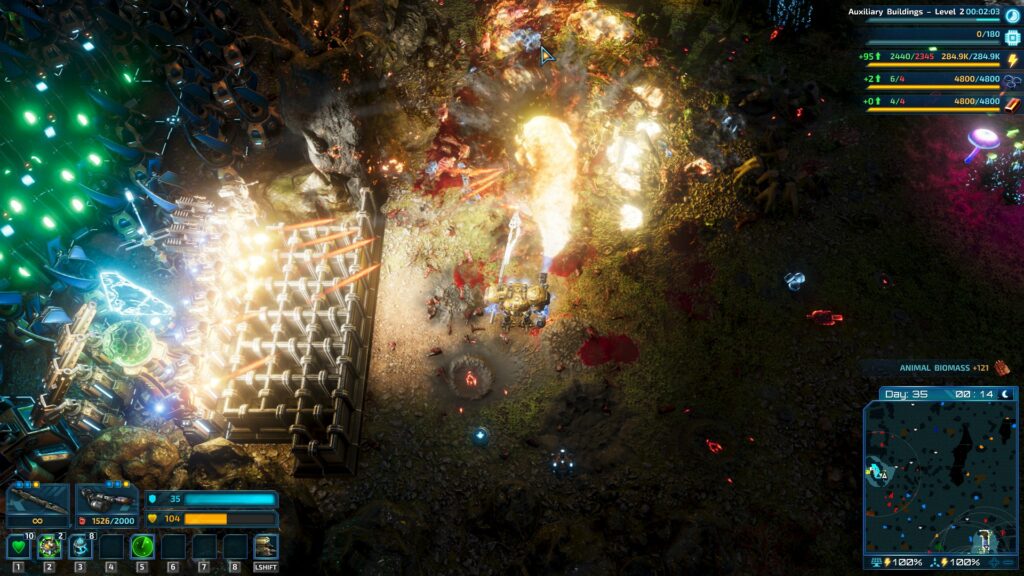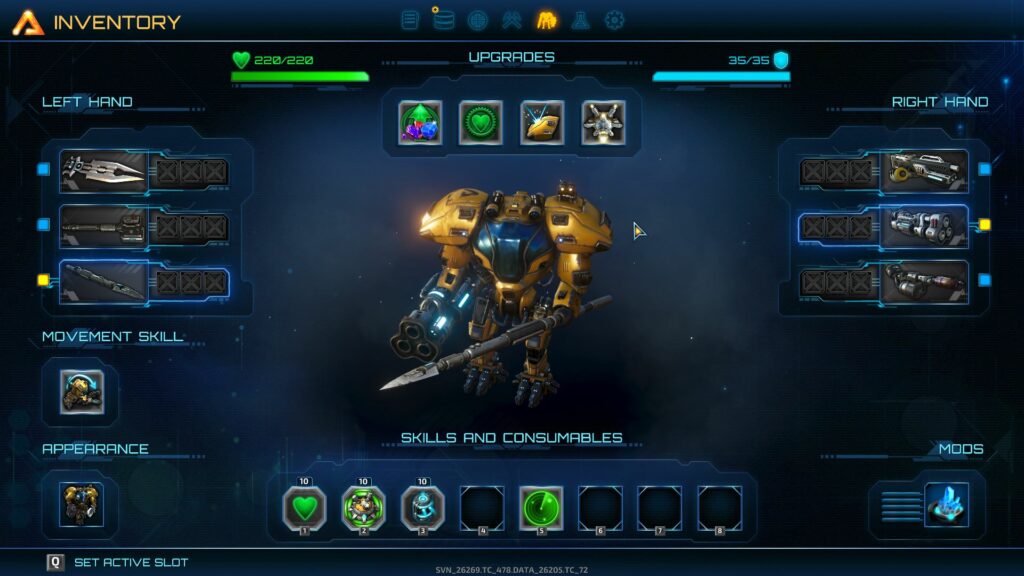
Developer: EXOR Studios
Publishers: EXOR Studios, Surefire Games
Platform: PC, PS4, PS5, Xbox One, Xbox Series X|S
Tested on: PC
The Riftbreaker – Review
Genre combinations are not an unknown concept, more often than not being done with closely similar ones. However, games doing this run the risk of not properly balancing said combination. The Riftbreaker is a recently released game attempting to cross base building with survival and RPG, and here is how it fares.
Story
The Riftbreaker’s story follows scientist Ashley S. Novak as she colonizes the planet Galatea 37, aided by her AI-powered mech-suit, Mr. Riggs. Other than an interesting concept, the game doesn’t really provide much in the way of a narrative, with a plot that doesn’t advance past the original premise. Throughout the whole campaign, players will only get to know Ashley somewhat better, although her characterization doesn’t develop much either.
Graphics
The graphics are one of the game’s fortes, thanks to its lush environments and unique sci-fi designs. Adding to this, the game features a wide array of different creatures throughout the different areas it includes. This also applies to all the machinery available for the player to place in their outposts, making each building easily distinguishable, even in more cluttered areas.
Sound
The game’s sound design is generally decent, with an alright if generic soundtrack, competent SFX, and pretty good voice acting. That said, both the sound effects and voice acting can easily become grating after a while, once the player has to deal with the constant full storage notifications and other quips from the characters.
Gameplay
Belonging to both the base building and RPG genres, The Riftbreaker’s gameplay sees players gathering resources from the environment to expand their base and further colonize the planet, the final objective being opening a portal connecting it with Earth. In order to manage all this, players will have a wide array of machinery at their disposal, the most important being mineral extractors and power generators. All of the game’s machinery requires to be connected to an energy grid to work, for which the player will need to manually set the cables and make sure the energy production surpasses the consumption.
As the game progresses, players will have to build more advanced pieces of machinery, which they’ll need to research first. Using the Communications Hub, players will slowly be able to obtain more and more blueprints, some of which will even require materials not found in the basic area. Once this happens, the game’s world will open up, allowing Ashley and Mr. Riggs to beam up to other parts of the planet.
These other areas are often more dangerous than the starting point, with inclement weather, dangerous beasts, and other hazards. After players have finished doing their initial exploration of the area and researched any possible tech needed to survive the new conditions, they’ll be able to set up an outpost in the new area.
Having to build smaller bases throughout the world is a common theme for the game, as most resources are non-renewable. Luckily for the players, thanks to the in-game rift technology, all of their storage will be linked from the get-go. However, that doesn’t mean any outposts or extraction bases can be left on their own, since they’ll require their own energy grid and defenses.
Said defenses are one of the most important parts of the game, since at intervals players will need to face waves of ravenous enemies. These waves will see players facing enormous amounts of aliens, whose power will only grow as the game progresses. What’s more, whenever players upgrade their central Headquarters, a “Boss Wave” will be triggered, adding especially strong enemies to the onslaught.
The combat itself is rather simplistic, best described as hack-n’-slash, providing players with weapon slots in total, where one half is for ranged weapons and the other half is for melee. While new weapons can be crafted later on, the balance is eschewed towards a particular few, which outclass the rest. The only real difficulty the combat provides is the possible damage to the player base, and the sheer number of enemies, which may overrun the player.
Alongside upgrading the Headquarters, players will also be able to do the same with any other buildings after the pertinent research has been finished. These upgrades will make buildings become more efficient, powerful, or simply unlock new things to create. Should a building or wall be damaged during an enemy attack, players will also be able to repair them, although later on, they’ll be able to automate this too.
Besides upgrading and improving their base, players will also be able to do the same with Mr. Riggs’ arsenal. Through further research and exploring the world, players will discover blueprints for strong weapons and modifications. Tying into this, The Riftbreaker also features a weapon mod system, providing players with additional features for their equipped tools. These mods can also be applied to the defensive turrets, although the system for doing so is much of a nuisance, with each tower requiring its own mod.
Other than the Campaign mode in which players will follow set objectives, the game also features a “Survival” mode, providing what the name entails. Additionally, both of the modes provide a decent array of difficulty settings alongside an optional Hardcore Mode with permadeath. For those who may be interested in streaming the game, a Streaming Mode allowing chat to influence the game is also provided.
Conclusion
Overall, The Riftbreaker is a rather good game that manages to properly do what it sets out to. That said, due to the genre combination it ends up as a jack-of-all-trades but a master of none. This means that the game is quite alright in its respective genres, but never truly excels at what it presents you with. While this might not be a perfect game for factory-builder veterans; newcomers or those looking for a simpler experience will definitely find it here. With a price point of €/$29,99/£24,99, the game is fairly priced for the meaty Campaign mode this game provides.
Personal Opinion
“I definitely enjoyed playing through The Riftbreaker, although I do think it could do with a few changes. While the wave system does add some variety, it can soon enough become a nuisance. The main base will defend itself easily enough, since it will already be the place with the most efficient energy grid and thus the easiest to set defenses for. However, any smaller mining outposts will most likely require player intervention to stay intact during a wave. For obvious reasons, wasting enough materials to protect a handful of mineral extractors from a full wave rarely ever is worth it. Especially taking into account once the ores deplete, it will have to be scrapped and moved elsewhere. If players were given the option to save setups and automatically build them, then perhaps it would be easier, but otherwise there is little incentive to invest in protection. Another gripe I had is the game’s lack of entertainment during downtime. Whenever I found myself waiting for my storage to fill up, I’d be left twiddling my thumbs, having already explored everything available in the areas. The game doesn’t really present depth of automation (such as allowing players to make more efficient systems), thus interaction with machines is limited to the initial placement. While there is a research “minigame”, aka aiming a beam at certain things to obtain information, the clumsiness with which it was handled and the lack of reward, besides database logs, made it uninteresting. Despite all of this, the game is still pretty good and entertaining to play while listening to a podcast or something similar.”
The Riftbreaker - Review,1 Comment
Leave a Reply
You must be logged in to post a comment.











[…] Studios has announced that The Riftbreaker’s long-awaited 2.0 Update will launch on the 25th of August for PC, with release dates for other […]